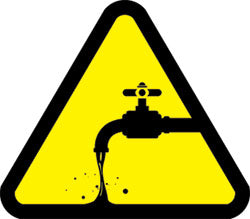
When most people turn on the faucet and cold, clear water flows out, they probably seldom think where that water came from.
If you get your water from a municipal water system, the process is pretty neat and involves processing, purification, storing, and transporting through a network of pipes intricately designed and plotted beneath the city.

Ever play an early version of Sim City? It was so hard to connect the water lines. Imagine doing it for real, with no cheat codes. Most engineered water supply networks are combined of many pieces. There is a water supply, which is usually called a watershed- a geographic area that collects the water. Then, there is a raw and untreated water reservoir that can be above or below ground. This could be a water tower, a lake, a river, or an underground aquifer. Then, there must be a means of delivery from the reservoir to a treatment facility, which could be underground piping, tunnels, or aqueducts. Then, of course, there is the treatment plant or facility. Once treated, the water is transmitted to treated water storage, which again could be above or below ground. And the final component of the system is the distribution method to individual homes, businesses, and public use such as hydrants. Water pressure is crucial to pumping water throughout all the many pipes through the system. Those are the components, which specifics will vary from town to town.
The water treatment facilities will vary from town to town and state to state as well, as there are different regulations. Of course, everything is also regulated by the EPA (Environmental Protection Agency) - meaning there are federal standards for safe drinking water. In 1974, congress passed the Safe Drinking Water Act, which was amended twice since its signing. This law laid the groundwork for standards that must be adhered to by municipalities and private water companies serving the public. The EPA website has full disclosure of every rule implemented, with rules that are currently being decided on. As health research is constantly being done, there are always new regulations. The EPA monitors for hundreds of organisms, metals, compounds, chemicals, and the like. For each contaminant, the EPA allows for a maximum number. When water is tested at the plants, it must meet or be lower than this specified number. If there is a spike, the customers must be notified. This is why you sometimes may see a "boil alert" on television. This means that a contaminant at a potentially unsafe level has entered the water supply.
Also, there are secondary contaminant guidelines, which are not enforced. These may cause cosmetic damage, such as skin and tooth discoloration, or aesthetic effects such as taste or odor. These include aluminum, chloride, copper, and many others. However, many of these are also linked to health effects. Therefore, even water treated at a plant may need to be filtered at home also.
Most water systems use the multiple-barrier method, much like water bottlers do, to remove these contaminants and to meet EPA guidelines. But also, things are sometimes added to the water. Not all, but some follow a process like this: At the treatment plant, chlorine is added to the water to kill bacteria; aluminum sulfate is added to coagulate organic particles; then the water is put into a settling basin to let the precipitate settle; the water it is filtered through sand filters; the water is treated with lime to adjust the pH, and finally is put into those storage reservoirs for home delivery.
Along with the Safe Drinking Water Act, everyone is allowed to know what is found in the water. In fact, annual reports by these companies are usually provided to customers along with their account statements.
Read Next: Different water filtration methods explained



